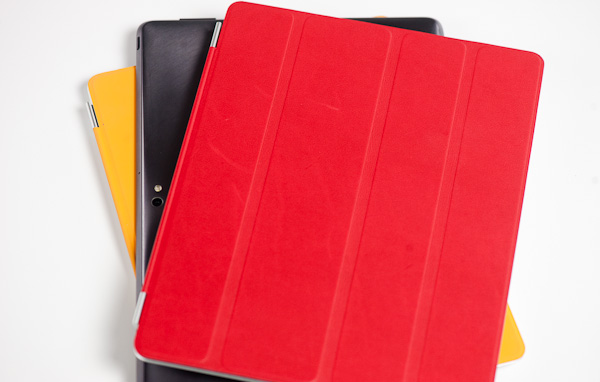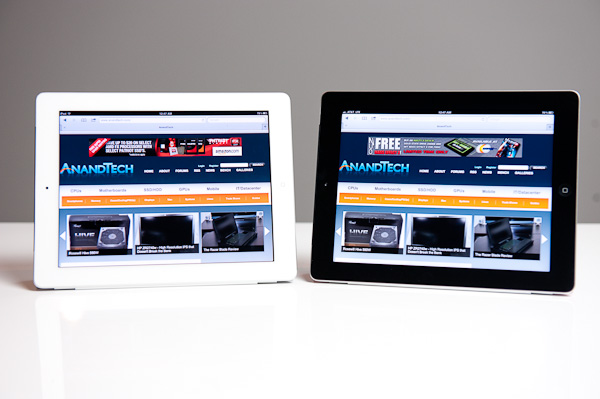The Apple iPad Review (2012)
by Vivek Gowri & Anand Lal Shimpi on March 28, 2012 3:14 PM ESTSince Apple launched the first iPad two years ago, the tablet market has evolved rapidly. While slate tablets were nothing new, the original iPad was the first serious tablet to be built around smartphone components and a user interface designed specifically for touchscreen input. The hardware was enough to run the OS smoothly while maintaining good battery life, the thin and light form factor lent itself to easy portability, and the touch-based user experience was miles better than earlier devices based on desktop operating systems.
We take it for granted now, but this was all news back in 2010, and the iPad was practically in a category of its own, with no real competitors to speak of. After Apple started shipping the iPad, the segment basically exploded—we had Google jump in with Honeycomb, HP got into it (and then out of it) with webOS, RIM had a go with the PlayBook, Amazon pushed the Kindle line into the tablet space, and Microsoft created its next release of Windows with tablets in mind. Along the way, Apple updated the iPad, both on the software side with multitasking, a new notifications system, and a myriad of UI updates, as well as launching second generation iPad hardware. The iPad 2 was a comprehensive update, bringing a dual core processor, unrivaled graphics performance, cameras fore and aft, and a ground up redesign that brought a thinner and lighter form factor.
The iPad 2 was a significant improvement over the original—faster, more portable, and generally a far more polished device. Not that it was perfect: iOS 4 still had issues with smooth multitasking and an archaic notifications system, the cameras were mediocre, and the XGA display, while a great quality panel, didn’t have the kind of pixel density expected of a premium mobile device. The iPad 2 hit market around the same time as Honeycomb (in Motorola’s Xoom) early last year, and at first Apple still held a major edge in terms of hardware. As more impressive Honeycomb devices like Samsung’s Galaxy Tab 10.1 and the ASUS Transformer Prime were launched, along with Ice Cream Sandwich looming on the horizon, Android became a much more viable tablet alternative to iOS. And with Microsoft planning for a major push later this year for ARM-based Windows 8 tablets centered around the Metro UI, Apple has never faced such stiff competition in the tablet space. Which brings us to the third generation of iPad hardware.
It has a display resolution that dwarfs most high-end desktop displays. The panel also puts a real emphasis on quality, not just resolution. For a computing device targeted squarely at the consumer market, both of these things are rarities.
Its SoC is the absolute largest ever squeezed into an ARM based tablet. The chip itself is even bigger than what you find in most mainstream notebooks. It’s expensive, it puts out a ton of heat and it offers a tremendous GPU performance advantage over anything else in its class.
And it has a battery that’s larger than what ships in the current crop of similarly sized ultraportables and Ultrabooks.
The new iPad doesn’t significantly change the tablet usage paradigm, but it does put all previous attempts at building hardware in this space to shame. It’s the sort of no holds barred, performance at any expense design that we’re used to seeing from enthusiast PC component vendors—but in a tablet...from Apple.
Welcome to the new iPad.












234 Comments
View All Comments
vol7ron - Thursday, March 29, 2012 - link
Think you meant "except" :)adityarjun - Friday, March 30, 2012 - link
No, you aren'tsiddharth7 - Friday, March 30, 2012 - link
Yeah! Kind of a typo :). Also forgot the question mark. :-)Wanted to edit it, but was not able to after posting. :)
Xyraxx - Thursday, March 29, 2012 - link
Ok, gaming clearly the TF came out ahead. Why the backhanded commentary in that section? I don't see that for the sections that the iPad clearly won. TF takes the overall top spot for its gaming performance. But instead of commentary on that, we get aggressive talk about how they should be pushing even further ahead, and how they are failing at it.The controller compatibility is an absolute win for the Android side, but instead of talk about that, we get this "Yeah, but who says controllers will win over touch". Its like every advantage the iPad doesn't win over, gets trotted out and downplayed as if to say it doesn't mean anything, or somehow doesn't matter.
darkcrayon - Thursday, March 29, 2012 - link
Interesting. I got a different impression entirely. It seems like games specifically optimized for the Tegra 3 by nVidia were somewhat better visuallyr, but the iPad has a more extensive game library and considering the GPU is far more powerful than the Tegra 3's, it's only a matter of time before there are far better graphics to be had on iPad games.Though there is no OS level controller support in iOS, both Bluetooth and dock connector controllers are possible (hence the iControlpad iCade, and a few others). It may be that more games support them now on Android, but nothing is stopping developers from supporting them on iOS at this point.
Finally, it's pretty important that ~100% of the iPad games in the App Store will run on the new iPad, which can't be said for the TF as shown in the review, or probably for any other individual Android tablet.
mr_ripley - Thursday, March 29, 2012 - link
It seems to me that the iPad does charge when I plug it into the USB port on my Macbook Pro. In fact I was surprised to see that not only did it not say "not charging" and show the "plugged-in" icon, it also seemed pretty fast (I will have to try it again to see if it was as fast as the power charger).However, when I tried to this morning to plug it into my Lenovo laptop it showed "not charging". Does this only work when plugged into Apple products?
vol7ron - Thursday, March 29, 2012 - link
This question seems better suited for the Apple support forums.doobydoo - Sunday, April 1, 2012 - link
This reply seems better suited to the kids-r-us forum.Aenean144 - Thursday, March 29, 2012 - link
Modern Macs have special USB hubs that output 7 to 8 Watts of power (~5V at ~1.6A). Most Windows machines or non-Macs and older Macs output about 4.5 Watts max. There's a USB battery charging specification, but I'm not aware of any computers that have this implemented.So, most Mac should be able to charge an iPod, iPad, iPhone relatively quickly. A PC with the normal USB specs will typically do it a little bit slower. 40 to 50%. 4.5 Watts is basically the bare minimum. Doable on an iPad 2 with the screen off, but the 2012 iPad will be tough. If you have the screen off, turn off WiFi and Bluetooth, it'll charge ok if Apple lets it. The screen has to be off with 4 Watt power source.
mr_ripley - Thursday, March 29, 2012 - link
Ah ha! Thanks for the clarification. When I saw that I was able to charge my new ipad while using it with my Macbook pro USB, I neglected to bring along my charger to work. Seems like that was unwise.But I still have around 50% power left so should be fine for today. And yes I do use it at work.